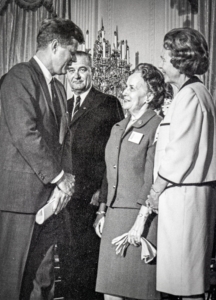
Oregon’s Edith Green Authored Pioneering Sexual Discrimination Law
Amid the unsettling Supreme Court decision on abortion rights last week, women’s advocates celebrated the 50th birthday of the groundbreaking 1972 Equal Opportunity in Education Act, better known as Title IX that outlawed gender discrimination in education. The celebration rekindled memories of its author, Oregon Congresswoman Edith Green.
Title IX was drowned out in history by the contemporaneous fight over the Equal Rights Amendment and the historic Supreme Court decision in Roe v. Wade in 1973. Fifty years later, only the 37 words in Title IX are still standing and changing the lives of American women everyday.
Title IX was renamed in 2002 as the Patsy Takemoto Mink Equal Opportunity in Education Act in honor of the first woman of color to be in elected to Congress in 1964. While Mink championed Title IX, Green wrote the bill and tirelessly pushed it through a male-dominated Congress with her Senate ally, Indiana Senator Birch Bayh. When she first introduced the bill in 1969, she had no cosponsors.
Green, who served 10 terms in Congress representing Oregon’s 3rd District, cut her legislative teeth by leading an eight-year battle to pass the Equal Pay Act of 1963, arguably the most significant advance for women since they earned the right to vote in 1920 following ratification of the 19th Amendment. Green introduced equal pay legislation in 1955 in her first year in office.

Oregon Congresswoman Edith Green introduced equal pay legislation in her first year in Congress in 1955. It passed eight years later with Green’s persistent advocacy and was signed into law by President Kennedy. Lyndon Johnson also praised Green for pushing through a breakthrough federal investment in higher education facilities.
Green devoted her energies in Congress to women’s issue, education and social reform. She wasn’t the darling of feminist leaders of her day because she vocally opposed busing to integrate schools and voted against adding gender as a protected class in the Civil Rights Act of 1964 out of fear it could torpedo the already contentious measure. To their credit, many feminists gritted their teeth and supported Green’s work on Title IX.
Green’s total body of work on education earned her the title in Congress of Mrs. Education. Her achievements included the Higher Education Facilities Act of 1963, which Lyndon Johnson called the most significant advance for higher education since the Land Grant Act of 1862. Green also created the first federal scholarships for college undergraduates.
Because Green and Mink worked on Title IX in the political shadows to avoid the controversies that adhered to the ERA and Civil Rights Act, congressional Republicans largely supported it. President Nixon signed the omnibus higher education bill into law in 1972 without mentioning Title IX, even though the deceptively simple language of Title IX was borrowed from the stricken sexual discrimination provision in the Civil Rights Act. Green’s subterfuge succeeded.
Title IX was aimed at sexual discrimination in hiring, promoting and enrolling women at colleges. Mink was denied entrance to multiple medical schools. Green never realized her dream of becoming a lawyer, but instead wound up writing laws.
Title IX has emerged as Green’s most enduring and visible contribution because it set in motion the phenomenal growth of women’s sports, which wasn’t necessarily one of her main objectives. “Once Title IX broke down those barriers, and let women and girls play sports, and said they have to be provided with equal opportunities, the girls came rushing through,” says Neena Chaudhry, with the National Women’s Law Center. “They came through in droves.”
Before the passage of Title IX, NCAA records show there were only 13 women’s collegiate soccer teams with 313 players in the 1971-72 season. There were so few teams that the University of North Carolina team, which included future star Mia Hamm, was forced to play high school teams to fill out their schedule. In the 2020-21 season, there were 28,000 players on 1,026 collegiate teams. Now more than 3 million women participate in some form of organized sports in America compared to 4 million men. The gap was far greater in 1972.
Women soccer players on the US National Team, including Megan Rapinoe who starred at the University of Portland from 2005-2008, have turned their success on the pitch into pay equity with their male counterparts, an achievement Green would have applauded twice.
From soccer, which offered colleges the best cost-benefit ratio to meet their Title IX obligations, often because of litigation, women’s collegiate sports has expanded to basketball, softball, track, tennis, gymnastics, field hockey, ice hockey and golf. March Madness now has two brackets that rivet national attention of female and male fans.
Green would have been equally proud of the network of Title IX compliance offices nestled in US four-year and community colleges that address claims of sexual discrimination, sexual harassment and sexual assault. These offices have provided college women a safe, private avenue to pursue their claims. The process is not always perfect, but it has removed predators from many college campuses.
Title IX is not out of the political woods yet. Its latest challenge centers on the rights of transgender youth to participate in sports in the gender they identify as.
Despite her achievements, Green is barely remembered these days. Her name, along with fellow Oregon Congressman Wendell Wyatt, graces a federal building in downtown Portland. The New York Times obituary marking her death in 1987 offers a more fitting remembrance:
“Former United States Representative Edith Green, a leading advocate of aid to education and women’s rights and an early opponent of the Vietnam War, died of cancer Tuesday night in Tualatin, Ore. She was 77 years old.
“Mrs. Green, a Democrat, started out as a schoolteacher and went on to serve 10 terms in Congress.
After defeating Tom McCall, who later became Governor of Oregon, Mrs. Green represented the state’s Third Congressional District from 1954 to 1974. She rose to the second-highest position on the House Education and Labor Committee and served as chairwoman of its Subcommittee on Higher Education. In that capacity, she pushed for passage of legislation creating the first federal scholarships for college undergraduates.
“Senator Mark O. Hatfield, a Republican who was a friend of Mrs. Green for 40 years, said yesterday: ‘’She was probably the most powerful woman ever to serve in the Congress. On any important legislation, such as women’s rights or education or dealing with minorities or poor people, she could switch people’s votes on the floor through the power of her intellect and her ability to persuade. People listened because when Edith Green spoke, she spoke from the heart as well as the mind.’”
She could switch people’s votes on the floor through the power of her intellect and her ability to persuade. People listened because when Edith Green spoke, she spoke from the heart as well as the mind.
The obituary also noted Hatfield’s admiration for Green’s decision in 1974 to walk away from a job at the height of her influence. “She did not run again when she could have been re-elected for life.” Instead, Green accepted an appointment five years later to the Oregon Board of Higher Education.




